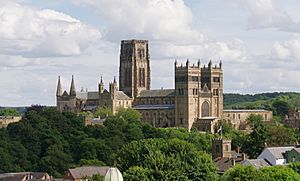Turgot of Durham facts for kids
Turgot (born around 1050, died 1115) was an important church leader. He was an Archdeacon and Prior at Durham in England. Later, he became a Bishop in Scotland. Turgot was also a close friend and advisor to a Scottish queen.
Contents
Who Was Turgot?
Early Life and Adventures
A Hostage and an Escape
Turgot grew up in a place called Lindsey in England. After the Normans took over England, Turgot was held as a hostage. This meant he was kept to make sure his family or group behaved. But Turgot managed to escape!
Teaching a King in Norway
After his escape, Turgot traveled to Norway. There, he taught the Norwegian king, Olaf III, how to sing psalms. Psalms are religious songs or poems.
Becoming a Church Leader
Joining the Monastery
Around 1074, Turgot returned to England. He started working as a clerk at a monastery in Jarrow. A monastery is a place where monks live and work. Later, he became a monk himself at Wearmouth.
Leading Durham Cathedral
In 1087, Turgot became the Prior of the monastery at Durham. A Prior is a leader in a monastery. From 1093, he also became the Archdeacon of Durham. This meant he had important roles in the church.
Friend to a Queen
Turgot became very close to the Scottish royal family. In 1089, he became a good friend and spiritual advisor to Queen Margaret of Scotland. She was married to King Malcolm III and was a very religious person. After her death, Turgot wrote a book about her life. He did this because her daughter, Matilda, asked him to.
Building a Great Cathedral
In 1093, Turgot and Bishop William de St-Calais started building something amazing. They laid the first stone for what would become Durham Cathedral. This is a very famous and beautiful church.
A Bishop in Scotland
Becoming Bishop of St Andrews
In 1107, Turgot was chosen to be the Bishop of St Andrews in Scotland. This area had not had a bishop since 1093. However, becoming a bishop was delayed. There were disagreements between church leaders in York and St Andrews.
Turgot finally became a bishop on August 1, 1109.
Facing Challenges
Being a bishop in St Andrews was not easy for Turgot. The church there was very simple. There were no Benedictine monks to help him, like he had in Durham. He also had to deal with disagreements between different groups. These included the Scottish King Alexander I and the Archbishop of York.
King Alexander asked the Pope, Paschal II, for advice. The Pope sent Turgot letters and a book of church laws to help him. Turgot wanted to go to Rome to talk to the Pope directly. But King Alexander did not let him go.
His Final Days
In June 1115, Turgot became very ill. He was allowed to return to Durham, where his church life had begun. He passed away on August 31, 1115. Turgot's last words were from a psalm: "His dwelling is in peace and his habitation in Sion." He was buried in the chapter house at Durham, near other bishops.


